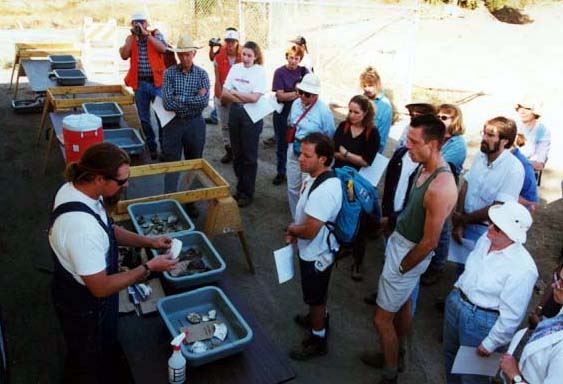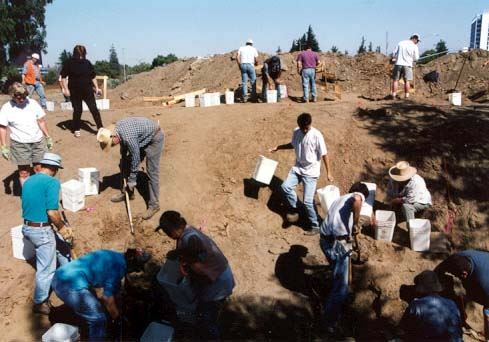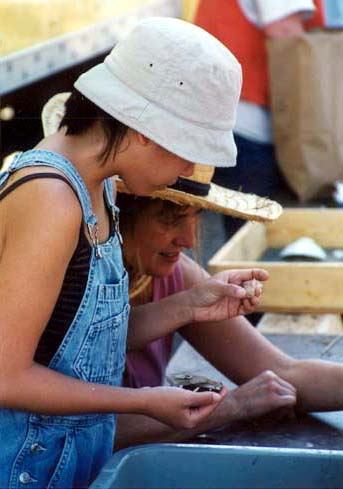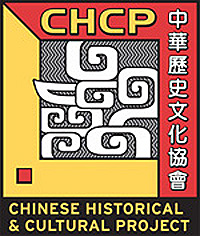|
- Home
- A Woolen Mills Chinatown Arch Jnl-8
A Woolen Mills Chinatown Archaeologist’s Journal -8
Text by Roman F. Beck and Rebecca Allen
Photographs by Jerry Doty
October 14-15, 1999: Volunteer Days
On October 14 and 15, 1999, we had an opportunity to give the public a “back-stage” pass to join in the discovery of the everyday life of the past. Media images generally portray archaeology as either a slow, tedious brushing away of dirt or as the swashbuckling heroics of Indiana Jones. Thankfully, our weekend was neither. Volunteers excavated, screened dirt, cleaned artifacts, or did all three activities over two days.
Our nearly 80 volunteers included local CHCP members, bottle collectors, school teachers, software engineers, and students. Perhaps not completely knowing what they were about to get themselves into, these hearty volunteers had the opportunity to dig in perhaps the messiest part of the site—the town dump. Prior to the arrival of the volunteer contingent, archaeologists laid out a grid system to control for provenience (that is, the three-dimensional location of artifacts). An archaeologist worked with each group of about six volunteers. This experience was wildly successful yet fairly exhausting. Everyone learned more about volunteer excavations.
 The archaeologists learned a valuable lesson when the local bottle collectors approached Mark Hylkema, the Caltrans Archaeologist in charge of the project, and asked him if they could search the site when we were finished. Instead, Mark involved them in our volunteer excavation days. We had a chance to share our knowledge about the importance of provenience and careful excavation. The Woolen Mills site was never disturbed, despite the site’s vulnerability. Collectors put the word out that this site was to be left alone, and that members would have the opportunity to dig at the site with archaeologists.
The archaeologists learned a valuable lesson when the local bottle collectors approached Mark Hylkema, the Caltrans Archaeologist in charge of the project, and asked him if they could search the site when we were finished. Instead, Mark involved them in our volunteer excavation days. We had a chance to share our knowledge about the importance of provenience and careful excavation. The Woolen Mills site was never disturbed, despite the site’s vulnerability. Collectors put the word out that this site was to be left alone, and that members would have the opportunity to dig at the site with archaeologists.
We wanted all our volunteers to feel as though they were a part of a real excavation, which they were, and not just grunt labor. Scott Baxter (in the lower left corner of the above photo) showed us the kinds of pottery, animal bones and other kinds of artifacts that the volunteers would probably find. Archaeologists generally don’t like surprises, so we thought that our volunteers should know what to expect too.
At the field lab
 Notice that all the volunteers in the above photo have some paperwork with them. Careful documentation is important in archaeology. Life is full of forms, and here archaeology imitates life. We record all that we see, so that others can evaluate our interpretations of what we saw. Armed with knowledge and tools, these helpers were ready for a dusty day full of excitement, banter, and discovery.
Notice that all the volunteers in the above photo have some paperwork with them. Careful documentation is important in archaeology. Life is full of forms, and here archaeology imitates life. We record all that we see, so that others can evaluate our interpretations of what we saw. Armed with knowledge and tools, these helpers were ready for a dusty day full of excitement, banter, and discovery.
The idea of “being sent to the pit” usually conjures up images of forced labor in a salt mine. Not here. This was fun time. Before the excavation started, we knew that many artifacts would appear over the weekend. Our volunteers were pleasantly surprised and happily rewarded. They dug the dirt with shovels and trowels, put the dirt into three-gallon white buckets, hauled the dirt up to the screens, and sifted the dirt through the screens.
“In the Pit”
With so many people in the dig area, all volunteers took turns excavating, preparing buckets, hauling buckets, and screening dirt. We changed jobs every half hour, so that everyone had a chance at the many different things that archaeologists do. This may seem physically difficult, but the generally careful and slow pace of documenting our observations makes the work more like leisurely gardening than to ditch digging. The first day is still exhausting though, as muscles we weren’t aware of get a workout.
Sorting the Artifacts

Lab work is always fun on hot days such as these. Thanks to good planning, some of the smarter archaeologists set up the lab on the shady side of the equipment truck. Once the artifacts were properly documented according to the location, we sent them in paper bags to the lab counter. Except for fragile metal objects, most of the artifacts were washed first. We kept the artifacts from each excavation area within a single drying screen, so that we wouldn’t mix things up. After the artifacts dried in the sun, we moved them to the table for sorting. One of the most important parts of archaeology is organizing or classifying artifacts. Humans by nature tend to organize and classify the world around them. Archaeologists are no different. We worked with volunteers to organize artifacts by the kinds of materials that they’re made, or to the types of activities that they’re related. We separated all animal bones from the glass bottles from the ceramic dishes and food storage jars, and domestic trash from industrial waste.
All in all, we recovered more than 30 archival boxes of materials from the volunteer excavations. Since October, lab technicians have been washing, sorting, and reassembling the artifacts. We typed in all of the artifact data into a computer program, adding to the information we had recovered from our Spring 1999 excavations. We’re starting to come up with some interesting patterns of consumer behavior, insights into food preparation and storage, general health of the population, and ties to the local economy.
To all the volunteers, thanks again for your help! Volunteers rule!
Back to (Journal -1) Week of April 26, 1999: Is Archaeology Glamorous?
Back to (Journal -2) Week of May 3, 1999: Surprises and Ceramics
Back to (Journal -3) Week of May 10, 1999: Field Photos
Back to (Journal -4) Week of May 17, 1999: Uncovering a Sense of Place and Space
Back to (Journal -5) Week of May 24, 1999: Fieldwork Wraps Up
Back to (Journal -6) Week of June 7, 1999: Roasting Kettle?
Back to (Journal -7) Week of July 26: Lab Work in Progress
Working with Caltrans are archaeological consultants from the firms of Past Forward, Inc., KEA Environmental, Inc., Foothill Resources, Inc., PAR Environmental, Inc., and the University of California, Chico.

